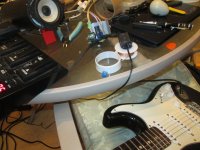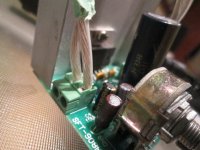Looks like I will have to go without lunch today!
After a month of sweet sounding amp..... nothing!
Turned on and dead as a dodo!
Got some genuine chips from RS, so will have to suck the old one out.
Good job I did'nt make a case for it!😱
After a month of sweet sounding amp..... nothing!
Turned on and dead as a dodo!
Got some genuine chips from RS, so will have to suck the old one out.
Good job I did'nt make a case for it!😱
My 2 amps have been on permanently for just over 2 years with no problems, but then I'm happy with the stock item. No uglyfiying for me.😉Looks like I will have to go without lunch today!
After a month of sweet sounding amp..... nothing!
Turned on and dead as a dodo!
Got some genuine chips from RS, so will have to suck the old one out.
Good job I did'nt make a case for it!😱
Hmm, those amps are a little more than lunch money?Ever tried a headphone amplifier (tpa6120) on those Tannoys?
I'm experimenting with a bluetooth receiver connected to my 7297 and a Blackberry Playbook and a Galaxy Tab 4, sounds very good, well worth the $17.
I have discovered that there are some really good quality audio files downloaded to Youtube.
Less than a business lunch 🙂
There might be little amps sold as headphone amps that have little trouble with the Tannoys, I don't know, just wondered. Could also be I have wrong load (for Tannoys) in mind or something else concerning big speakers vs tiny headphones that upsets the amps.
There might be little amps sold as headphone amps that have little trouble with the Tannoys, I don't know, just wondered. Could also be I have wrong load (for Tannoys) in mind or something else concerning big speakers vs tiny headphones that upsets the amps.
0.47uF Nichicon ES (Muse ES is a bi-polar made-for-audio cap priced $0.06~$0.11) should be 0db down by 41hz, the lowest note of the bass guitar. That seems appropriate for this size amplifier.
Question...
Is there a way to wire this to get MONO output?
I too am interested in bridging the two channels. I'd like to use two bridged amps to play my Pono player in balanced mode.
If not bridged, I suppose I could run each balanced cable to a single channel of separate amps.
0.47uF Nichicon ES (Muse ES is a bi-polar made-for-audio cap priced $0.06~$0.11) should be 0db down by 41hz, the lowest note of the bass guitar. That seems appropriate for this size amplifier.
Except I found out they try to polarize, so they aren't the best. They sound good briefly, then it trails off.
Got one of this, changed out the electrolytic caps with with problem.
Cooked a PCB pad when I was trying to replace the smaller electrolytic with film.
Just saw one on Flea bay that has film caps.
Was sounding pretty good with just the power cap upgrade.
Back to the drawing board ...
Cooked a PCB pad when I was trying to replace the smaller electrolytic with film.
Just saw one on Flea bay that has film caps.
Was sounding pretty good with just the power cap upgrade.
Back to the drawing board ...
Well, I've launched an IndieGoGo in order to simplify the buying process. It's not an official "group buy" like on the forum, so much as it has to be crowd funded because I don't have the cash around.
$200, that's expense account lunch money!Well, I've launched an IndieGoGo in order to simplify the buying process. It's not an official "group buy" like on the forum, so much as it has to be crowd funded because I don't have the cash around.
@DestroyerOS
Are you going to add more details on the Indiegogo page? Like [strike]price[/strike] (200$ oops), what does it include etc? Right now I only see a part of a design file screenshot as picture.
Also what kind of transformer? R-core, toroid, EI?
The chip allows for separate power supply on each channel. Did you wire them in parallel or does it have separate ps on each one?
Also I don't know if on Indiegogo or Kickstarter but I knew that you must have a real working product that you need to show in the campaign.
Are you going to add more details on the Indiegogo page? Like [strike]price[/strike] (200$ oops), what does it include etc? Right now I only see a part of a design file screenshot as picture.
Also what kind of transformer? R-core, toroid, EI?
The chip allows for separate power supply on each channel. Did you wire them in parallel or does it have separate ps on each one?
Also I don't know if on Indiegogo or Kickstarter but I knew that you must have a real working product that you need to show in the campaign.
Last edited:
More details will be added. In the gallery you can see the full PCB photos.
It's a Hammond 185 series to be specific.
The chip doesn't actually allow for separate power supplies. The internal resistance between the pins is less than 2ohm, so it's more likely one is voltage reference. (I don't own a lab so I can't take the chip apart)
It's a Hammond 185 series to be specific.
The chip doesn't actually allow for separate power supplies. The internal resistance between the pins is less than 2ohm, so it's more likely one is voltage reference. (I don't own a lab so I can't take the chip apart)
$200, that's expense account lunch money!
20x lunches! I'm actually surprised how well the price came out for the premium parts, and after reduces it two two PCB's. I've easily spent that with shipping for other chipamp kits and transformers that were not as impressive, no where nearly interesting enough to make me want to develop them in particular.
My friend who owns a Bryston 3BSST(2) and Piega 5.2 Premiums told me, and I quote, "if I didn't already have the Bryston, I would be begging you to build me one." But then he made a charitable contribution to get the demo going (expensive when order only a few PCB's, chassis, etc). I'll go back to his place and he'll want the final version of mine more than his Bryston 😀
I can see how the difference in price is big, but if you look at the performance, shipped, I'd say it's a steal.
Destroyer OS.;4315201 I can see how the difference in price is big said:Is the performance real or perceived?
It's more interesting than just that! Not only does upgrading the Chinese one provide clearly audible differences, several changes to my version have as well. One cannot mistake a version with the Kmultiplier for one without, nor the input caps for being audibly obvious in improvement particularly in resolution and neutral behavior.
And yet the performance of the chips I buy are measurably better. I've had one playing at 23~v for over a week! The kit is regulated at 18v with 1% resistors. Most of the Chinese ones pop at 18v, so they rate them lower. They're selling you factory seconds.
And yet more! You can defiantkey measure a difference in AC across the caps for power, inductance is lower, and the capacitors are over 3x lower resistance and inductance than a single before adding the copper pour into the calculation... and they're much better values to begin with! So yes, there's a readily measurable difference in noise.
The chip's output in distortion won't be particularly different at a quick glance, but one could use a high resolution DAC to find differences. The RF/noise is worse on the sound. The chip has very pleasant distortion and clipping, but all the RF/noise mutilating the signal has an unpleasant, irritating signature.
And yet the performance of the chips I buy are measurably better. I've had one playing at 23~v for over a week! The kit is regulated at 18v with 1% resistors. Most of the Chinese ones pop at 18v, so they rate them lower. They're selling you factory seconds.
And yet more! You can defiantkey measure a difference in AC across the caps for power, inductance is lower, and the capacitors are over 3x lower resistance and inductance than a single before adding the copper pour into the calculation... and they're much better values to begin with! So yes, there's a readily measurable difference in noise.
The chip's output in distortion won't be particularly different at a quick glance, but one could use a high resolution DAC to find differences. The RF/noise is worse on the sound. The chip has very pleasant distortion and clipping, but all the RF/noise mutilating the signal has an unpleasant, irritating signature.
- Home
- Amplifiers
- Chip Amps
- What the heck? It's less than lunch!

